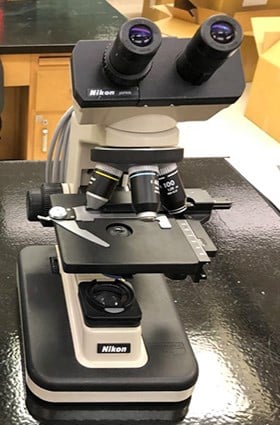 Learning will have new focus for hundreds of Saskatoon Public Schools' high school students thanks to a significant contribution from the College of Medicine at the University of Saskatchewan.
Learning will have new focus for hundreds of Saskatoon Public Schools' high school students thanks to a significant contribution from the College of Medicine at the University of Saskatchewan.
Eighty-four microscopes that were once used in undergraduate teaching labs now have new homes in the school division's classrooms. Although used, the high-quality Nikon microscopes represent a significant upgrade from many of those currently utilized in high school science courses.
"The teachers were very excited and enthusiastic about the prospect of receiving these microscopes," said Tina Rioux, a science teacher at Nutana Collegiate and educational consultant with the school division. "These microscopes are still in excellent working order and will be an asset in our buildings. Teachers are very excited to trade out some of our old and poorly functioning microscopes for these much higher quality instruments."
The division's current complement of microscopes is aging and requires more work to keep them functioning properly. The significant cost of purchasing a single microscope makes it difficult to replace them in a timely manner for student learning.
The microscopes became available when Health Sciences received funding to acquire new microscopes for its undergraduate teaching labs. Finding a new home where the instruments would be well utilized and be an asset to teaching and learning was the goal of Cindy Thomson, a Biomedical Sciences instructional support technician who coordinated the donation.
Collegiate science teachers use microscopes in their life science courses and units including classes such as Biology 30, Health Science 20, Environmental Science 20, Science 10, and Science 9.
"The microscopes will be used by a variety of students and assist science teachers with engaging students so they may see themselves in the field of science. Helping students get a better picture of the world around them gives them a broader sense of how they are connected to their environment," Rioux said.
 With two ocular tubes (eyepieces), quality objective lenses, and better magnification the microscopes donated by the university will provide a more satisfying learning experiences for students and teachers, who are often challenged by instruments that in some cases have reached their fourth decade of classroom use.
With two ocular tubes (eyepieces), quality objective lenses, and better magnification the microscopes donated by the university will provide a more satisfying learning experiences for students and teachers, who are often challenged by instruments that in some cases have reached their fourth decade of classroom use.
"The learning experience will be improved because previously students would try and do all the right procedural steps for microscope use but the objective lenses in the older scopes were unable to hold focus and resolution," Rioux explained. "Consequently, students were requiring help and had to wait patiently for the teacher to be able to visit each group. It was extremely frustrating to do microscope labs."
Staff from each of the collegiates were able to pick up their school's allocation of microscopes during the first week of June, as well as supplies such as extra bulbs and fuses that accompanied each set of microscopes.
The microscopes will have a significant impact on learning, both in terms of how teachers will use them as part of their instruction and how students will be able to better explore and understand science within the classroom.
"We are very excited about these new microscopes at my school and how much more efficient the process will be for students," Rioux said.